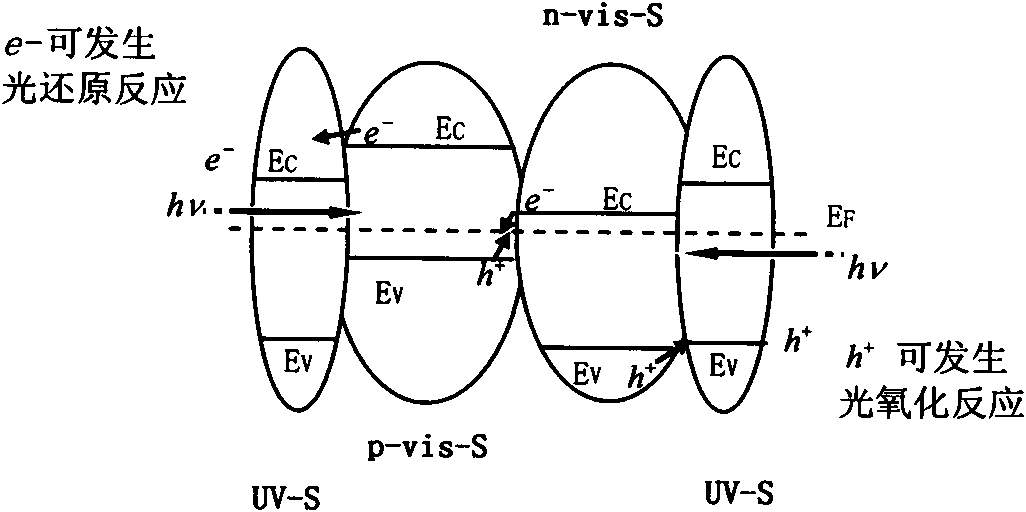Ternary core-shell composite photocatalyst and preparation method thereof
A catalyst, core-shell type technology, applied in the field of photocatalysis, can solve the problems of poor photochemical corrosion resistance, low utilization rate of sunlight, and intolerance to high-energy photons, etc., to achieve good photocatalytic water splitting hydrogen production performance, good light Effect of Catalytic Degradation of Dye Wastewater
- Summary
- Abstract
- Description
- Claims
- Application Information
AI Technical Summary
Problems solved by technology
Method used
Image
Examples
Embodiment 1
[0025] TiO 2 / WO 3 -CuAlO 2 Preparation
[0026] (1) Semi-wet synthesis of CuAlO 2 :
[0027] Weigh 5g Cu(NO 3 ) 2 ·3H 2 O, and Al(NO 3 )·9H 2 O, 7.7g, respectively dissolved in deionized water to obtain 20% by mass copper nitrate solution and aluminum nitrate solution, and then add 25% by mass oxalic acid solution to the copper nitrate solution to form copper oxalate precipitation, The molar ratio of oxalic acid to copper is 1.2:1, and the obtained precipitate is filtered and washed and mixed with aluminum nitrate solution, and evaporated to dryness in a water bath at 80° C. under continuous stirring. The evaporated solid is calcined at 1000℃ in nitrogen atmosphere for 6h to prepare CuAlO 2 . After grinding, pass through a 300 mesh sieve for use;
[0028] (2) Synthesis of WO by precipitation loading method 3 -CuAlO 2 :
[0029] Take 2g CuAlO made from (1) 2 , The number of moles is 0.0163mol, weigh 4.13g of ammonium tungstate, and the number of moles of tungsten contained in it is ...
Embodiment 2
[0037] TiO 2 / WO 3 -CuAlO 2 Photocatalytic water splitting performance test
[0038] (1) Use light deposition method on TiO 2 / WO 3 -CuAlO 2 Surface load Pt:
[0039] Will H 2 PtCl 6 Dissolved in anhydrous ethanol solution to prepare a solution with a mass concentration of 1% based on Pt, and then use the TiO prepared in Example 1 2 / WO 3 -CuAlO 2 Put the powder in it, irradiate it with a 250W halogen lamp while magnetically stirring for 0.5h, then filter, and dry at 120°C to obtain a catalyst for photocatalytic water splitting to produce hydrogen;
[0040] Of which Pt and TiO 2 / WO 3 -CuAlO 2 The mass percentage = 0.2%.
[0041] (2) Performance test of catalyst photocatalytic decomposition of water to produce hydrogen.
[0042] Take 0.5g of the above Pt-loaded TiO 2 / WO 3 -CuAlO 2 Photocatalyst, placed in a 1000mL quartz glass reactor, add 800mL deionized water and 0.5g anhydrous Na 2 CO 3 (Make the solution pH=11). Then the reactor is connected to a closed system, and it undergoes th...
Embodiment 3
[0048] TiO 2 / WO 3 -CuAlO 2 Performance Test of Photocatalytic Degradation of Acid Red B
[0049] Take the TiO prepared in Example 1 2 / WO 3 -CuAlO 2 0.1g of catalyst, placed in an 800mL beaker, add 600mL of acid red B solution with a concentration of 10mg / L, magnetically stir for 0.5h in the dark state, take samples, and measure the concentration of acid red B with a spectrophotometer as the undegraded acidity The concentration of red B, after irradiating with a 300W xenon lamp for 1h, the concentration of acid red B is measured, which is the concentration of acid red B after degradation. The decolorization rate of acid red B is calculated by the following formula.
[0050]
[0051] The result is: TiO 2 / WO 3 -CuAlO 2 Under the action of the catalyst, the decolorization rate of Acid Red B was 95.2% after 1 h.
PUM
| Property | Measurement | Unit |
|---|---|---|
| concentration | aaaaa | aaaaa |
| decolorization rate | aaaaa | aaaaa |
| decolorization rate | aaaaa | aaaaa |
Abstract
Description
Claims
Application Information
 Login to View More
Login to View More - R&D
- Intellectual Property
- Life Sciences
- Materials
- Tech Scout
- Unparalleled Data Quality
- Higher Quality Content
- 60% Fewer Hallucinations
Browse by: Latest US Patents, China's latest patents, Technical Efficacy Thesaurus, Application Domain, Technology Topic, Popular Technical Reports.
© 2025 PatSnap. All rights reserved.Legal|Privacy policy|Modern Slavery Act Transparency Statement|Sitemap|About US| Contact US: help@patsnap.com



